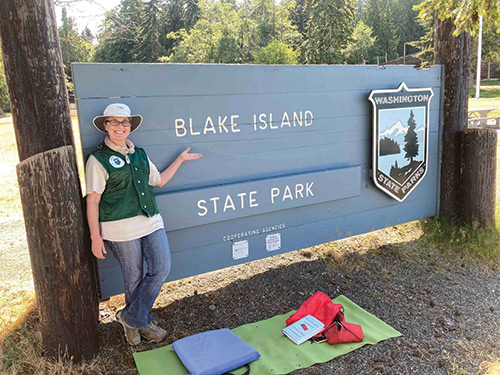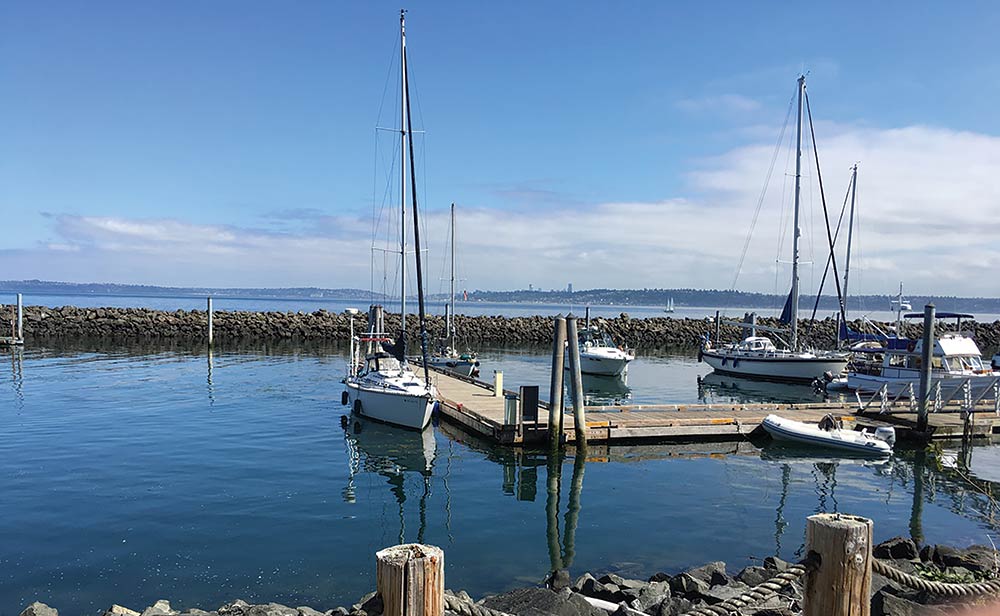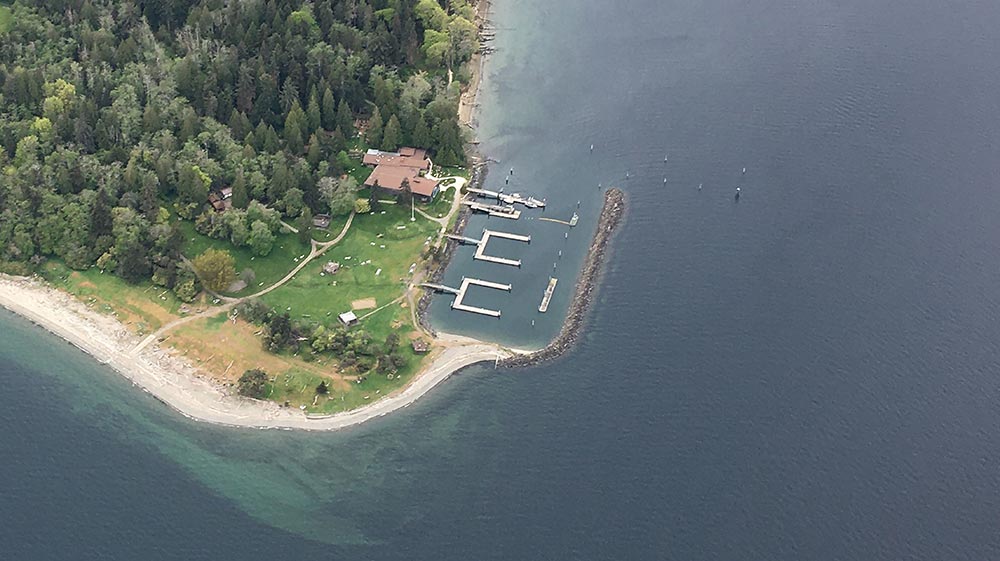
Have you ever considered being a volunteer host for the Washington State Park system? Perhaps you’ve met a host at a drive-in campsite. Did you know that if you have a boat, you could be a host at one of the Marine State Parks? Blake Island Marine State Park is one of these wonderful places, and my wife Linda and I hosted for the first time at Blake this August.
We have been recreational boaters for over 30 years and have a Hunter 31, Faster Horses, which is berthed in the Duwamish. As Seattleites, we can see Blake Island on a clear day, and we have always loved visiting the island for day trips and overnights. Though it is just 8 nautical miles from Seattle, being on Blake Island always feels far away.
Most Puget Sound boaters will be familiar with 470-acre Blake Island, which is all forested except for the marina and camping areas on the northeast tip. Before it was a state park, Blake Island was the getaway estate for the wealthy Trimble family in the 1920s. Today, there are 5 miles of shoreline, multiple tent campsites, 8 miles of hiking trails, and three Cascadia Marine Trail kayak camps. For boaters, there are 24 mooring buoys surrounding the island and 1,500 feet of moorage in a side-tie arrangement in the marina. All of the moorage choices are first-come-first-served, with a maximum stay of three nights.

What is Hosting All About?
To be a marina host, State Parks requires you to have some experience with boating and marina operations. The very efficient Volunteers Office suggested that all adult companions who would be present during our host week also sign up — during busy times, having two hosts really helps.
We sent in our application forms, and were background-checked and fingerprinted. When accepted, we were given the contact number for Blake Island’s senior park ranger, Ranger Paul. He gave us a great description of the duties and how things worked. At Blake, the intent is to have hosts onsite for one-week intervals (typically Monday to Monday) from May through September, with other weeks of the year staffed during holiday periods.
A few weeks before we were scheduled to host, we decided to cruise over to Blake Island for a few nights, where we learned about the host duties from long-time volunteers Tom and Shirley. They were very kind and it really made our learning curve easier as we jumped into the flow as hosts ourselves.
When our hosting week came, we loaded up the boat and departed early from Harbor Island. It was the start of Seafair week, and we needed to avoid the boat parade on Elliott Bay. Faster Horses was full of potable water, fuel, and provisions — the boat was as heavy as it has ever been. I rolled the jib out and we sailed from Duwamish Head to our state park home for the week. We arrived with no issues, and got the boat settled for a good stay with power cords and shade tarps deployed. At Blake, there is a designated marina spot with a power hookup for the host’s boat.
The ranger on duty gave us a brief on the responsibilities, and we were given a volunteer information binder and vests that identified us as park volunteers. Like at the land-based parks, our duties were to assist the rangers and staff by handling questions, giving advice, reminding visitors of rules, and assisting in registration and attendance counts. Rangers Paul and Steven live on the island full-time during their work weeks and will resolve any issues that the hosts need assistance with. In general, their hands are full managing the campground, trails, wildlife, facilities, and being out on the water to patrol the mooring buoys. The state asks that hosts wear PFDs while on duty out on the docks, just like they require of their employees. Linda and I wore lightweight inflatable PFDs that were comfortable over the mesh volunteer vests, even in the hot weather.
Hosts on Duty

Hosts are on duty during the busy times at the marina — late morning through late afternoon. One of the marina host’s main roles is to keep track of the lengths of the open spaces at the docks, to advise the skipper which float to head for, and to prevent boats wandering around looking for a spot in the tight marina space. There are white paint marks along the toe rails at 5 foot intervals. This helps, but then the host has to estimate the length of the boat coming in, which is a bit harder to do. So, we tried to ask the incoming captains what the length overall was for their vessel as they were arriving. The host is there for advice and counsel; the decisions of if and where to moor are ultimately the responsibility and choice of the skipper.
From the deck of our boat at the host dock, we could see boats coming into the narrow entrance channel, and would then walk out to the end of the float to communicate with the incoming boat. This worked well during slow times. When things got busier, Linda and I found it easiest to use walkie-talkies — she stood on the shore bluff atop the marina and would alert me to incoming boats and available lengths of tie-ups (or that the marina was full); I would be down at the end of the float closest to the channel entrance communicating with the skippers. When boats were tying up, we would occasionally assist by holding dock lines or even advising less experienced boaters. As a rule, however, State Parks asks volunteers not to handle or tie-up visiting boats.
We would remind incoming boaters of the payment scheme and location of the pay stations, the need for dogs to be on leash at all times when off a boat, and the need to close all windows and hatches when ashore due to the presence of raccoons who have learned to find food inside boats.
Visitors’ boat sizes varied from kayaks up to 50-60 foot yachts. Boaters’ skills ranged from brand new members of shared boat clubs to highly experienced ocean-going licensed captains.
Many smaller boats come for the day, while others are hoping to spend a few nights. Some come in to use the 30-minute loading/unloading zone to ferry campers and camping equipment; and enforcing the time limit was also among our responsibilities as hosts. There’s a rule that one person is to stay with the boat while docked in this zone, but it’s not a hard rule, as we could only advise visitors. Truly enforcing rules is the rangers’ domain. All of the camping gear and supplies comes and goes through the marina, up a gangway, and on to the campgrounds about a quarter mile away over dirt paths. The park has two hand carts and a wheelbarrow to move equipment. However you’re moving the gear, it is much easier at high tide! Most folks were very respectful of the time limit, but a few wandered onto the island and didn’t return in a timely manner. Incidentally, the loading zone was even used by a runabout with worries of an engine cooling problem.
While small runabouts could often be jigsaw-puzzled in, it was hard to find enough lineal feet for larger boats. When we did find room for a large yacht, the modern automated docking aids were impressive to watch — sensing the dock location and driving the bow and stern thrusters accordingly. Blake Island’s marina design is a parallel parking scheme, which is not great for some boats and operators, especially sailboats and powerboats without bow thrusters on windy days. A typical summertime north wind on Blake turns eastward when it hits the north face of the island, and gets directed across the marina, tending to blow boats away from the east sides of the floats. When this happens, don’t panic, just back out and try it again.
In the early evening, the marina hosts walk through the marina to take attendance for the ranger, make sure each overnighting boat has a posted pay slip, and that those with a State Moorage Pass have paid for power. All the while, we checked dock lines and answered questions from any of the boaters.

Our Week as Hosts
On Tuesday, our first full day as hosts, we were immediately busy greeting and sending arriving boats on to empty spots along the dock floats. As the day wore on, we began to find our rhythm — Linda was quicker to get to the far docks to share the rules, raccoon warnings, and park info; while I looped back to the next boat coming in the channel. Just walking back and forth on the docks led to a lot of mileage – over 10,000 steps every day of our week at Blake Island. From time to time, while I was busy with one boat, another would come in. Other boaters were super helpful lending a hand with the newcomers.
Thursday was a reasonably quiet day in the marina compared to the three days before, and the weekend days brought crowds that were full-on all day and into the evening. Luckily by that time, we were into a routine. Since check-out time is 1:00 p.m., many boats start leaving around then, and new boats start arriving. The peak busy time for a marina host guiding boats into empty spots seems to be 11:00 a.m. to 2:00 p.m. On the busiest days, the marina was full by 2:00 p.m. — then the waving off began.
A host may tell you the marina is full when you, the boat captain, can see smaller open spots. The host is telling you that the marina is full for your length of the boat. One or two smaller boats may get in later. Just about all the captains were polite when told we were full. One or two boats headed over to the row of pilings on the north side of the inner harbor and tied up — mooring on the pilings is a bit more inconvenient as the captain and crews have to monitor their lines with the changing tides, and also dinghy in to come ashore to pay fees.
On a few days, we got up with the sun to do some hiking before heading out on the floats to meet the arriving boaters in the late morning. In the evenings, we watched the sunset behind the Olympics, and then it quickly got very dark and quiet.
One great part of being a Marina Host was talking with people from around the world who are visiting or working in the Seattle area, having their first trip to Blake. Just during our week, we had boats with Australian, Norwegian, and Nigerian visitors who heard about Blake and came to explore. And of course, many Canadian friends arrive, cruising down from British Columbia.
Most of our days at Blake were quite hot, and it was great to have Faster Horses there so we could stay hydrated and relax in the shade when time allowed. We brought along a tiny portable ice machine and it did a really nice job making little ice cubes for drinks.
For us, this was the longest stay on the boat away from resupplies, and the trip was a good test of logistics. Our 33 gallon potable water tank went bingo toward the end of the week, but I had a 6 gallon mule up on deck that saw us through. Our holding tank made it the entire time, but we had made a note to use the park facilities as often as possible. With the portable ice maker, the cold box stored perishables just fine.

Blake Island Tips and Information
- Blake is definitely a popular place, and weekends are busiest by far. Plan ahead and have a backup plan of where to go if the marina is full or the weather suddenly turns foul. Sometimes, you just have to take a chance — there is no webcam, there are no radios to call ahead.
- One tactic to try to get a spot is mooring just outside the channel on a mooring ball, and then watching for a boat your size to leave the marina.
- At present, there is a study going on to improve/renovate the Marina moorage, which was installed in 1975 and is due for a redesign.
- Tillicum Village cultural center, salmon dinners, and the tour boat service to Blake are now on a ‘pause’ after Argosy ended their relationship as a Parks concessionaire in the spring of 2022. State Parks is searching for a new concessionaire and intends to carry on the Suquamish Tribe’s involvement in future plans.
- The pumpout station at Blake is out of service with no plans for it to return. Also, there is no garbage disposal on the island, it is “pack it in, pack it out.”
- In the 30-minute loading zone, one adult has to stay with the boat at all times in case it has to be moved.
- Rangers Paul and Steven run a tight ship on Blake and it was great to work as hosts with them. They were actively enforcing rules for visitors who tried to burn driftwood, made noise overnight, didn’t pay, and for parents that didn’t have PFDs on young ones. They fined one visitor whose dogs were still off-leash after a warning.
It was a great week at Blake volunteering as hosts. We came away with a real admiration for Rangers Paul and Steven, the staff, and all that the State Parks system does to support Blake Island. If you’re interested in becoming a Marine State Park Host, learn more at: parks.wa.gov/get-involved/volunteer-program/park-host-program
Neal and Linda Chism
Neal and Linda Chism are long time Seattle residents who get out on the water as often as possible. Neal is a retired aerospace engineer, and Linda is still on the job at Alaska Airlines.






